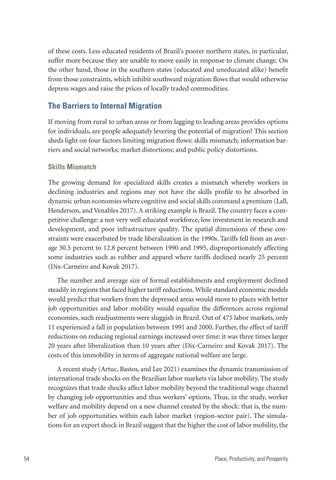of these costs. Less educated residents of Brazil’s poorer northern states, in particular, suffer more because they are unable to move easily in response to climate change. On the other hand, those in the southern states (educated and uneducated alike) benefit from those constraints, which inhibit southward migration flows that would otherwise depress wages and raise the prices of locally traded commodities.
The Barriers to Internal Migration If moving from rural to urban areas or from lagging to leading areas provides options for individuals, are people adequately levering the potential of migration? This section sheds light on four factors limiting migration flows: skills mismatch; information barriers and social networks; market distortions; and public policy distortions.
Skills Mismatch The growing demand for specialized skills creates a mismatch whereby workers in declining industries and regions may not have the skills profile to be absorbed in dynamic urban economies where cognitive and social skills command a premium (Lall, Henderson, and Venables 2017). A striking example is Brazil. The country faces a competitive challenge: a not very well educated workforce, low investment in research and development, and poor infrastructure quality. The spatial dimensions of these constraints were exacerbated by trade liberalization in the 1990s. Tariffs fell from an average 30.5 percent to 12.8 percent between 1990 and 1995, disproportionately affecting some industries such as rubber and apparel where tariffs declined nearly 25 percent (Dix-Carneiro and Kovak 2017). The number and average size of formal establishments and employment declined steadily in regions that faced higher tariff reductions. While standard economic models would predict that workers from the depressed areas would move to places with better job opportunities and labor mobility would equalize the differences across regional economies, such readjustments were sluggish in Brazil. Out of 475 labor markets, only 11 experienced a fall in population between 1991 and 2000. Further, the effect of tariff reductions on reducing regional earnings increased over time: it was three times larger 20 years after liberalization than 10 years after (Dix-Carneiro and Kovak 2017). The costs of this immobility in terms of aggregate national welfare are large. A recent study (Artuc, Bastos, and Lee 2021) examines the dynamic transmission of international trade shocks on the Brazilian labor markets via labor mobility. The study recognizes that trade shocks affect labor mobility beyond the traditional wage channel by changing job opportunities and thus workers’ options. Thus, in the study, worker welfare and mobility depend on a new channel created by the shock: that is, the number of job opportunities within each labor market (region-sector pair). The simulations for an export shock in Brazil suggest that the higher the cost of labor mobility, the
54
Place, Productivity, and Prosperity

